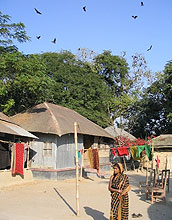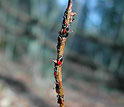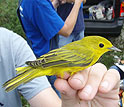|

Press Release 08-160
NSF, NIH Award Ecology of Infectious Disease Grants

Scientists to study links between environmental changes, spread of infectious diseases
September 18, 2008
Unprecedented changes in biodiversity have coincided with the emergence and re-emergence of infectious diseases around the world. To address this problem, the National Science Foundation (NSF) and the National Institutes of Health (NIH) have announced $16 million in funding for eight projects under the Ecology of Infectious Diseases (EID) program, a multi-year, joint-agency effort now in its ninth year of funding. "In a time of rapid global change, the one certainty is that emerging infectious diseases will be more common," said James Collins, NSF assistant director for biological sciences. "These new EID research awards will support the basic studies needed to predict the timing and severity of the emergence and spread of these diseases."
NSF's contribution to the EID program is from its Directorates for Biological Sciences; Geosciences; and Social, Behavioral & Economic Sciences. Interdisciplinary projects funded through the EID program will study how large-scale environmental events--such as climate change, habitat destruction, biological invasions, pollution and a variety of interventions--alter the risks of viral, parasitic and bacterial diseases in humans and animals. "Ecological studies of infectious diseases are beginning to move from basic science to translational research," said Joshua Rosenthal, EID program director at NIH's Fogarty International Center. "The results will help us to better manage these diseases." The studies will contribute knowledge and analytical tools that will help public-health officials, wildlife managers, farmers and others to control the spread of diseases among humans, domestic and wild animals, and crops, say EID scientists. This year's awards support research on: - Bacterial pathogens and human infectious diseases in an estuary subjected to extreme climatic events (Rachel Noble, University of North Carolina at Chapel Hill);
- Virulence trade-offs in a vertebrate virus--infectious haematopoietic necrosis (IHN)--a disease of salmon and trout (Benjamin Kerr, University of Washington);
- Agricultural antibiotics and human health, using a multi-scale ecological approach to the development and spread of antibiotic resistance (Joseph Eisenberg, University of Michigan);
- Environmental determinants favorable for the presence and transmission of vibrios, bacteria typically found in saltwater and important human pathogens (Crystal Johnson, University of Southern Mississippi);
- Eco-epidemiology of West Nile virus emergence in urban areas (Tony Goldberg, University of Wisconsin at Madison);
- "Immune landscapes" of human influenza in households, towns and cities of southern China (Derek Cummings, Johns Hopkins University);
- Ecology, emergence and pandemic potential of Nipah virus, a virus harbored in fruit bats, in Bangladesh (Peter Daszak, Consortium for Conservation Medicine at Wildlife Trust);
- Ecology of anaplasmosis, a tick-borne disease in cattle, and the relationship of disease reservoirs, risk and incidence (Felicia Keesing, Bard College).
The coincidence of broad-scale environmental changes and the emergence of infectious diseases points to underlying and predictable ecological relationships, said Rosenthal. "The EID program links these components to produce a comprehensive understanding of disease transmission," he said. Potential benefits of the EID program include development of more advanced disease transmission theory; improved understanding of unintended health effects of development projects; increased capacity to forecast outbreaks; and better comprehension of how diseases emerge and re-emerge.
-NSF-

Media Contacts
Cheryl Dybas, NSF (703) 292-7734 cdybas@nsf.gov
Ann Puderbaugh, NIH (301) 402-8614 puderba@mail.nih.gov
Related Websites
NSF Ecology of Infectious Diseases Program: http://www.nsf.gov/funding/pgm_summ.jsp?pims_id=5269
NIH Ecology of Infectious Diseases Initiative: http://www.fic.nih.gov/programs/research_grants/ecology/
Ecology of Infectious Diseases: An NSF Special Report: http://www.nsf.gov/news/special_reports/ecoinf/index.jsp

The National Science Foundation (NSF) is an independent federal agency that
supports fundamental research and education across all fields of science and
engineering, with an annual budget of $6.06 billion. NSF funds reach all 50
states through grants to over 1,900 universities and institutions. Each year,
NSF receives about 45,000 competitive requests for funding, and makes over
11,500 new funding awards. NSF also awards over $400 million in
professional and service contracts yearly.
 Get News Updates by Email Get News Updates by Email
Useful NSF Web Sites:
NSF Home Page: http://www.nsf.gov
NSF News: http://www.nsf.gov/news/
For the News Media: http://www.nsf.gov/news/newsroom.jsp
Science and Engineering Statistics: http://www.nsf.gov/statistics/
Awards Searches: http://www.nsf.gov/awardsearch/
| 




